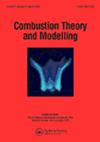A modified thickened flame model for simulating extinction
IF 1.9
4区 工程技术
Q4 ENERGY & FUELS
引用次数: 1
Abstract
For large-eddy simulation of turbulent premixed reacting flows, major challenges stem from the inability to resolve the flame in a computationally affordable manner. These challenges are most evident in combustors characterized by large domains and thin flames. In these applications, the thickened flame model may be used to extend the flame artificially to a numerically resolvable size through a thickening factor. Thicker flames exhibit suppressed wrinkling in the presence of turbulence, so an efficiency factor increases the flame speed without influencing flame thickness. In contrast to the detailed considerations of unresolved turbulent flame wrinkling, recent work shows that thickened flames do not respond correctly to resolved-scale stretch. In this work, errors in stretch-induced extinction are considered. The already established effect of thickening on extinction is illustrated, and the effect of efficiency factor is characterized in detail. Significant errors in extinction stretch rate are observed analytically and numerically in twin premixed counterflow flame simulations. In general, the original thickened flame formulation does not permit control over extinction, in contrast to its control over freely-propagating-flame thickness and speed. For reactant mixtures with a Lewis number greater than 1, a novel modification of the thickened flame formulation is presented, and through Lewis number adjustments, extinction errors are significantly reduced, while key flame thickening and speed properties of the original formulation are preserved. A test case featuring a turbulent premixed bluff-body-stabilized flame demonstrates that the extinction errors of the original formulation can lead to premature blowoff dynamics and significant statistical errors, if the grid is too coarse. The modified thickened flame model applied to the same grids addresses this issue and provides reasonable flame predictions on all grids, indicating the potential for extending this combustion model to resolutions of greater engineering relevance.模拟熄灭的改进加厚火焰模型
对于湍流预混合反应流的大涡模拟,主要挑战源于无法以计算上可负担的方式解析火焰。这些挑战在以大面积和细火焰为特征的燃烧器中最为明显。在这些应用中,增稠火焰模型可以用于通过增稠因子将火焰人为地扩展到数值上可分辨的尺寸。较厚的火焰在存在湍流的情况下表现出抑制的褶皱,因此效率因子在不影响火焰厚度的情况下增加了火焰速度。与未解决的湍流火焰褶皱的详细考虑相反,最近的工作表明,增厚的火焰对已解决的尺度拉伸没有正确响应。在这项工作中,考虑了拉伸引起的消光的误差。说明了增稠对消光的影响,并详细描述了效率因子的影响。在双预混逆流火焰模拟中,从分析和数值上观察到消光拉伸率的显著误差。通常,与控制自由传播的火焰厚度和速度相比,原始增稠火焰配方不允许控制熄灭。对于路易斯数大于1的反应混合物,提出了对增稠火焰配方的新改性,通过路易斯数的调整,消光误差显著降低,同时保留了原始配方的关键火焰增稠和速度特性。一个以湍流预混钝体稳定火焰为特征的测试案例表明,如果网格过于粗糙,原始配方的消光误差可能导致过早的井喷动力学和显著的统计误差。应用于相同网格的改进的增稠火焰模型解决了这一问题,并在所有网格上提供了合理的火焰预测,这表明有可能将该燃烧模型扩展到具有更大工程相关性的分辨率。
本文章由计算机程序翻译,如有差异,请以英文原文为准。
求助全文
约1分钟内获得全文
求助全文
来源期刊

Combustion Theory and Modelling
工程技术-工程:化工
CiteScore
3.00
自引率
7.70%
发文量
38
审稿时长
6 months
期刊介绍:
Combustion Theory and Modelling is a leading international journal devoted to the application of mathematical modelling, numerical simulation and experimental techniques to the study of combustion. Articles can cover a wide range of topics, such as: premixed laminar flames, laminar diffusion flames, turbulent combustion, fires, chemical kinetics, pollutant formation, microgravity, materials synthesis, chemical vapour deposition, catalysis, droplet and spray combustion, detonation dynamics, thermal explosions, ignition, energetic materials and propellants, burners and engine combustion. A diverse spectrum of mathematical methods may also be used, including large scale numerical simulation, hybrid computational schemes, front tracking, adaptive mesh refinement, optimized parallel computation, asymptotic methods and singular perturbation techniques, bifurcation theory, optimization methods, dynamical systems theory, cellular automata and discrete methods and probabilistic and statistical methods. Experimental studies that employ intrusive or nonintrusive diagnostics and are published in the Journal should be closely related to theoretical issues, by highlighting fundamental theoretical questions or by providing a sound basis for comparison with theory.
 求助内容:
求助内容: 应助结果提醒方式:
应助结果提醒方式:


